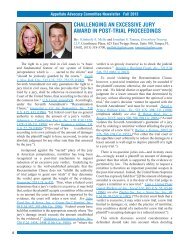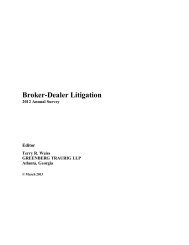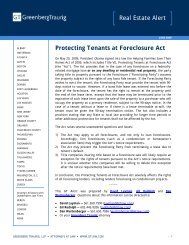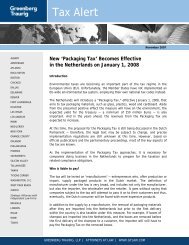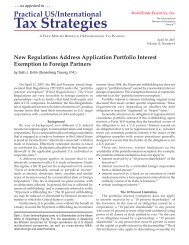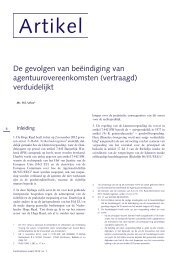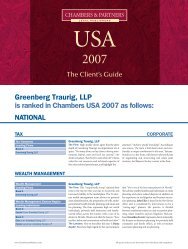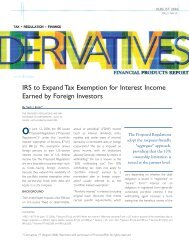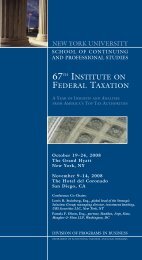Mortgage-Backed Securities Litigation - Greenberg Traurig LLP
Mortgage-Backed Securities Litigation - Greenberg Traurig LLP
Mortgage-Backed Securities Litigation - Greenberg Traurig LLP
Create successful ePaper yourself
Turn your PDF publications into a flip-book with our unique Google optimized e-Paper software.
<strong>Mortgage</strong>-<strong>Backed</strong> <strong>Securities</strong> <strong>Litigation</strong>: Claims and Defensive Strategies<br />
By Victor Vital and Aiesha Redmond<br />
W<br />
hat do Charles Schwab<br />
Corp.; MBIA, Inc.; Ambac Financial<br />
Group, Inc.; and various Federal Home<br />
Loan Banks have in common? They have<br />
all sued major banks in connection with<br />
the mortgage-backed securities (MBSs)<br />
Vital<br />
issued by those banks. A couple of the<br />
latest entrants to this fray are Allstate<br />
and the TIAA-CREF fund family, having<br />
sued Bank of America’s Countrywide<br />
mortgage unit in late December 2010 and<br />
in January 2011, respectively. See Mark<br />
Jewell, Investors Allege Massive Fraud by<br />
Countrywide, Associated Press, Jan. 25,<br />
Redmond<br />
2011, www.bloomberg.com/news/<br />
2011-01-25/investors-allege-massive-fraud-by-countrywide<br />
.html. The real estate “bubble” that popped in 2007 is<br />
credited widely to mortgages extended to unworthy borrowers<br />
to feed the mortgage-securitization machine.<br />
The wave of current litigations shows that MBSs have<br />
come full circle, with investors and insurers seeking recourse<br />
against major banks for these bank-created and marketed<br />
products. But are the extra-contractual theories asserted in<br />
these lawsuits novel, or do they actually resemble past claims<br />
by sophisticated parties concerning bank-created and bankmarketed<br />
products? Moreover, will the investors and insurers<br />
be successful on their extra-contractual claims?<br />
These lawsuits assert extra-contractual theories that are<br />
standard fare for dissatisfied yet sophisticated purchasers of<br />
bank-marketed products. Banks in the past have argued that<br />
tort theories of recovery fundamentally change the risk allocation<br />
contemplated by the contracts that were executed in full<br />
view of the transaction’s risks. How the present MBS-related<br />
claims will be resolved remains to be seen, but banks will<br />
likely defend these extra-contractual theories using welldeveloped<br />
arguments from past cases.<br />
<strong>Mortgage</strong>-Loan Securitization<br />
Securitization is a process by which intangible and illiquid<br />
assets are monetized into cash. Securitization is also the term<br />
used to describe the process of issuing securities backed by the<br />
cash flows from a pool of underlying assets. D. Michael Long<br />
& Gregory Rohan, “The Securitization of Assets: The New<br />
Finance,” 7 Int’l J. Bus. Strategy 142 (2007).<br />
<strong>Mortgage</strong>-<strong>Backed</strong> Securitization<br />
MBSs are asset-backed securities or debt obligations that<br />
represent claims on the cash flows from securitized mortgage<br />
loans. These securitizations are done by government<br />
agencies, government-sponsored enterprises, and private<br />
entities. Most MBSs are issued by the Federal National<br />
<strong>Mortgage</strong> Association (Fannie Mae) and the Federal Home<br />
Loan <strong>Mortgage</strong> Corp. (Freddie Mac). Private institutions,<br />
however, such as brokerage firms, banks, and homebuilders,<br />
also securitize mortgages known as “private-label” mortgage<br />
securities. U.S. <strong>Securities</strong> & Exchange Commission,<br />
<strong>Mortgage</strong>d-<strong>Backed</strong> <strong>Securities</strong> (July 23, 2010), www.sec.gov/<br />
answers/mortgagesecurities.htm.<br />
Though MBSs are considered complex, the process<br />
through which banks create them is rather straightforward.<br />
First, a bank aggregates hundreds if not thousands of mortgages<br />
that the bank has originated or acquired from other<br />
originators. Second, these pooled loans are transferred into<br />
a trust formed to issue securities backed by the pooled loans,<br />
i.e., MBSs. Banks create these trusts, which are bankruptcyremote<br />
entities, to separate the ultimate MBS investors from<br />
the banks’ credit risk. Third, the trust issues MBSs from the<br />
pooled loans transferred by the bank, in a transaction underwritten<br />
by the bank.<br />
MBSs are well established in the world of finance as a<br />
1980s creation of Wall Street. In their early years, MBSs<br />
were backed by the best of mortgage loans—those extended<br />
to solvent, credit-worthy borrowers. The biggest<br />
risk associated with MBSs in those days was the risk of<br />
early payment. With mortgage holders having the option<br />
of prepaying their mortgages, this accelerates the cash<br />
flows to the investors, who receive the principal payments<br />
early but do not receive the future interest payments that<br />
would have been made on that principal. Because MBSs<br />
are essentially a claim on future cash flows from a pool of<br />
mortgages, prepayment of the loans, which borrowers typically<br />
do when rates fall, diminishes an investor’s return,<br />
leaving the investor with cash to then invest, but in a<br />
lower-rate environment. The advent of subprime mortgage<br />
securitization, however, introduced a new risk: the<br />
risk of nonpayment.<br />
The difference between securitized pools consisting of<br />
credit-worthy borrowers versus subprime borrowers is huge. If<br />
a mortgage pool is comprised of credit-worthy borrowers who<br />
consistently pay in a timely manner, MBS holders have a high<br />
degree of confidence in a steady flow of income. On the other<br />
hand, if the mortgage pool is subprime, or at risk for missed<br />
payments or nonpayment, then MBS holders should not have<br />
the same degree of confidence. However, subprime MBS<br />
investors are compensated for that risk through higher returns<br />
on their investments.<br />
Published in Commercial & Business, Volume 12, Number 3, Spring 2011. © 2011 by the American Bar Association. Reproduced with permission. All rights reserved. This information or any portion thereof<br />
may not be copied or disseminated in any form or by any means or stored in an electronic database or retrieval system without the express written consent of the American Bar Association.
Underwriting, Insurance, and Assurances<br />
To enhance the marketability of MBSs, the bank or its<br />
affiliate sponsoring the MBS transaction obtains insurance<br />
to guaranty payment on the MBSs. To secure that insurance,<br />
banks make representations and warranties to financial guaranty<br />
insurers. Those representations and warranties concern,<br />
among other things:<br />
■■<br />
■■<br />
■■<br />
the accuracy of the information supplied in connection<br />
with the financial guaranty transaction;<br />
the selection of loans for the securitizations based<br />
upon an acceptable quality benchmark; and<br />
adherence to appropriate and reasonable underwriting<br />
guidelines in respect to originating the underlying<br />
mortgage loans, as well as appropriate and<br />
reasonable loan-servicing practices in respect to the<br />
underlying mortgages.<br />
These same types of representations are made in the contract<br />
documents under which investors such as pension funds,<br />
hedge funds, Fannie Mae, and Freddie Mac purchase MBSs.<br />
Contract-Based Risk Allocation and Remedy<br />
Investors evaluate risk primarily based on whether the issuer<br />
is private or government-backed, the quality of the underlying<br />
mortgage loans, and the credit enhancement or credit<br />
ratings afforded to the securities. Generally speaking, there<br />
is no imbalance of sophistication or bargaining power among<br />
the parties to these transactions, given that both the investors<br />
and the insurers are well-established and known entities like<br />
TIAA-CREF, Fannie Mae, and Ambac.<br />
As one would imagine, MBS issuances and the underlying<br />
guaranty transactions are “papered” heavily with investors,<br />
insurers, and MBS sponsors and issuers generally relying on<br />
their freedom of contract to negotiate a specific allocation<br />
of risks with the benefit of due diligence and appropriate<br />
professional advice and counsel. For insurers, the agreed-upon<br />
bargain includes being paid substantial premiums in exchange<br />
for making payments on a policy.<br />
The extent to which banks retain recourse liability is one<br />
of many items heavily negotiated between the parties. The<br />
parties might agree that the bank retains no recourse; that it<br />
incurs conditional or limited recourse; or that it provides full<br />
recourse. Generally, investors or insurers negotiate and secure<br />
substitution or repurchase provisions, worded along the following<br />
lines:<br />
Upon discovery or upon notice of a breach of any<br />
representation or warranty set forth with respect to any<br />
loan that materially and adversely affects the interests<br />
of the parties in such a loan [the bank] shall, within 90<br />
days after the earlier of its discovery or receipt of notice<br />
thereof, either cure such breach in all material respects<br />
or (i) repurchase such a loan from the trust at the<br />
repurchase price or (ii) substitute one or more eligible<br />
substitute loans for such a loan.<br />
The Downturn of MBSs<br />
When the U.S. housing market collapsed, imploding home<br />
prices resulted in precipitously rising foreclosures. Obviously,<br />
in view of the wave of subprime mortgage loan defaults that<br />
ensued, the value of MBSs plunged from investment-grade<br />
securities to junk-bond status. This was because the cash flows<br />
from securitized mortgages were substantially lower than the<br />
MBS investors desired, given the numerous loan defaults.<br />
This, in turn, caused a shortfall in funds available to pay<br />
the interest mandated by the MBSs, bringing with it massive<br />
numbers of defaults by the issuers of the MBSs. In other<br />
words, the investment decisions made by the investors and<br />
the guaranty transactions entered into by the insurers ran in<br />
the opposite direction of what they desired.<br />
Investors and insurers are now pressing claims on the<br />
representations and warranties, alleging that banks securitized<br />
loans that failed to meet the<br />
representations and warranties<br />
due to things such as<br />
inflated appraisals, overstated<br />
borrower income figures, and<br />
borrowers failing to occupy<br />
the mortgaged homes. But<br />
the investors and insurers<br />
are also asserting extra-contractual<br />
theories premised on<br />
theories of reliance as well as<br />
implied-contractual duties.<br />
While banks thus far<br />
The extent to<br />
which banks<br />
retain recourse<br />
liability is one<br />
of many items<br />
negotiated.<br />
have resisted purchasing the alleged defective mortgages<br />
cart blanche, the larger question concerns the propriety and<br />
strength of the extra-contractual claims asserted in respect to<br />
the allegedly defective mortgages.<br />
Typical Claims Asserted by Plaintiffs<br />
Contract-Breach of Representations and Warranties<br />
In most instances, banks make representations and warranties<br />
with respect to each mortgage loan sold. A breach of contract<br />
occurs when the representations and warranties referenced<br />
earlier turn out to be false. This is the most straightforward<br />
claim and is premised upon the deal struck between the parties<br />
in the underlying transaction documents.<br />
Fraudulent Inducement<br />
To assert a fraudulent inducement claim, an investor or insurer<br />
must show that the bank represented that a material fact<br />
was true for the purpose of inducing the plaintiff to rely on it,<br />
knowing the representation was false. And, notably, a fraud<br />
plaintiff must have been justified in relying on the alleged<br />
Published in Commercial & Business, Volume 12, Number 3, Spring 2011. © 2011 by the American Bar Association. Reproduced with permission. All rights reserved. This information or any portion thereof<br />
may not be copied or disseminated in any form or by any means or stored in an electronic database or retrieval system without the express written consent of the American Bar Association.
misrepresentation, causing the plaintiff to enter the transaction<br />
and suffer loss and damages.<br />
Negligent Misrepresentation<br />
Investors and insurers also are asserting negligent misrepresentation<br />
claims, alleging that banks negligently supplied false<br />
information in respect to the MBS transactions. Like fraud<br />
claims, negligent misrepresentation claims require a showing<br />
of justifiable reliance.<br />
Breach of Implied Duty of Good Faith and Fair Dealing<br />
Investors and insurers often allege a breach of the duty of<br />
good faith and fair dealing, arguing that the banks failed<br />
to disclose information about the quality of mortgage loans<br />
and MBSs.<br />
Defending Against Extra-Contractual Claims<br />
Attacking Justifiable Reliance<br />
Sophisticated commercial parties in heavily papered<br />
transactions generally take a number of steps to protect<br />
their financial interests. In an MBS transaction, for instance,<br />
an investor or insurer will typically secure as much<br />
information as it deems necessary in the due diligence<br />
process. This point, however, sets up the argument that<br />
the MBS investor or insurer did not justifiably rely on any<br />
oral or written representation of the bank, particularly<br />
in transactions that include<br />
Investors and<br />
insurers often<br />
allege a breach<br />
of the duty of<br />
good faith and<br />
fair dealing.<br />
comprehensive merger-andintegration<br />
clauses and that<br />
involve the disclosure of copious<br />
amounts of information<br />
and data.<br />
An example of this defensive<br />
point can be found<br />
in United Guaranty <strong>Mortgage</strong><br />
Indemnity, Co. v. Countrywide<br />
Financial, Corp., 660 F. Supp.<br />
2d 1163 (C.D. Cal. 2009). In<br />
this particular case, an insurer<br />
brought suit against a lender, alleging that the lender falsely<br />
represented that the mortgage loans were originated “in strict<br />
compliance with the originator’s underwriting standards<br />
and guidelines.” The court dismissed the insurer’s fraudulent<br />
inducement claim, however, stating that “any reasonable<br />
mortgage insurer that (1) was conducting multibillion-dollar<br />
transactions and (2) had an express right to audit or sample<br />
the underlying loan files before the transaction closed, would<br />
engage in some degree of auditing or sampling of the underlying<br />
loan files to be insured.”<br />
Because MBS investors and insurers receive substantial duediligence<br />
information, banks will likely mount “justifiable reliance”<br />
attacks arguing that these sophisticated plaintiffs cannot<br />
establish such reliance and, thus, cannot assert reliance-based<br />
claims such as fraud and negligent misrepresentation. While a<br />
non-sophisticated plaintiff could complain that the truth was<br />
buried in voluminous data, it will be difficult for a sophisticated<br />
party to so complain.<br />
Breach of Contract Masquerading as Fraud<br />
In many states, a line of argument has evolved disallowing<br />
a plaintiff to allege a fraud claim based upon alleged<br />
misrepresentations that are not independent of the underlying<br />
contract. Hawthorne Group, LLC v. RRE Ventures, 776<br />
N.Y.S.2d 273, 276 (N.Y. App. Div. 2004) (dismissing fraud<br />
claims arising from alleged breaches of warranty dependant on<br />
the underlying agreement). Under that theory, fraud claims<br />
will be dismissed as duplicative of breach of contract claims<br />
where the tort claims are derived directly from the terms of<br />
the agreement.<br />
Banks defending against fraud and negligent misrepresentation<br />
claims should argue that these claims are merely<br />
breach-of-representation and warranty claims masquerading as<br />
tort claims. In that respect, the underlying transaction documents<br />
define the parties’ rights and obligations. If the bank’s<br />
representations prove false, the failure of the representation<br />
constitutes a breach of contract claim for which contract<br />
law provides an appropriate remedy. RGH Liquidating Trust<br />
v. Deloitte & Touche, <strong>LLP</strong>, 851 N.Y.S.2d 31 (N.Y. App. Div.<br />
2008) (affirming the dismissal of fraud claims as duplicative of<br />
breach of contract claims where fraud claims were “based on<br />
alleged fraudulent misrepresentations related to defendants’<br />
obligation under their agreements . . . and allege no misrepresentations<br />
collateral or extraneous to the agreements”).<br />
This principle was demonstrated recently in Lone Star Fund<br />
v. Barclays Bank PLC, in which a purchaser of MBSs asserted<br />
a fraud claim based on the allegation that certain representations<br />
about the loans were falsely made. The court held that<br />
there was no actionable misrepresentation or fraud where the<br />
contract warranties provided that if any of the loans did not<br />
meet certain representations, the bank would repurchase or<br />
substitute them. Even where investors and insurers claim that<br />
banks were aware of the poor loan quality, fraud claims will be<br />
dismissed if they are derived from the terms of the contract.<br />
Lone Star Fund V (US), LP v. Barclays Bank PLC, 594 F.3d<br />
383, 389 (5th Cir. 2010) (stating that “a sophisticated investor<br />
placing a $60 million investment in the trusts . . . has no<br />
basis to ignore these provisions or their consequences”).<br />
Defense Against Implied Covenant of Good Faith and Fair Dealing<br />
A cause of action for breach of the implied duty of good faith<br />
and fair dealing will not succeed where it is duplicative of the<br />
breach of contract claim. See, e.g., R.I. Island House, LLC v.<br />
N. Town Phase II Houses, Inc., 858 N.Y.S.2d 372, 377 (N.Y.<br />
App. Div. 2008). This particular cause of action cannot be<br />
used as a “pile-on” claim, where underlying documents are<br />
specific as to issues in disputes. Any related damages must be<br />
Published in Commercial & Business, Volume 12, Number 3, Spring 2011. © 2011 by the American Bar Association. Reproduced with permission. All rights reserved. This information or any portion thereof<br />
may not be copied or disseminated in any form or by any means or stored in an electronic database or retrieval system without the express written consent of the American Bar Association.
ecovered in the context of the breach of contract claim. Levi<br />
v. Utica First Ins. Co., 786 N.Y.S.2d 3 (N.Y. App. Div. 2004).<br />
In Levi, the plaintiffs brought a breach of contract claim<br />
and breach of the implied duty of good faith claim against an<br />
insurer, claiming that the insurer intentionally misrepresented<br />
certain terms in the policy. The court held that these claims<br />
“are redundant since a breach of the implied duty of good<br />
faith and fair dealing is intrinsically tied to the damages allegedly<br />
resulting from the breach of the contract.”<br />
Thematic Defenses<br />
Sophistication. Sophisticated investors are deemed to have<br />
sufficient investing experience and knowledge to weigh the<br />
risks and merits of an investment opportunity. The investor<br />
base remains overwhelmingly institutional. The MBS transaction<br />
participants, including the guaranty insurers, are “big<br />
boys” that can look out for and protect their own interests. As<br />
knowledgeable and sophisticated counterparties, MBS investors<br />
and insurers can do a number of things to protect themselves,<br />
including request and obtain appropriate financial and<br />
other disclosures; undertake extensive due diligence; retain<br />
and use legal, financial, and other professionals; and negotiate<br />
and secure appropriate consideration, risk-mitigation provisions<br />
and remedies. Furthermore, most modern transaction<br />
documents traditionally contain provisions emphasizing the<br />
equality of bargaining power, adequate and equal access to<br />
sufficient underlying data, and access to qualified legal and<br />
other professionals.<br />
These points should be developed fully and used prominently<br />
during pretrial discovery, particularly during depositions,<br />
and later at trial.<br />
“A deal is a deal.” The reality is that all MBS transaction<br />
participants are financially sophisticated, enter into<br />
these transactions knowing exactly what they are buying<br />
in terms of the quality of the investments, and understand<br />
the risks that they are taking. Now that some of the highyielding<br />
investments are not working out as planned, some<br />
investors want to blame someone for the fact that the declining<br />
economy caused their investments to lose value and<br />
are crying foul play. These investors made an informed and<br />
heavily negotiated investment and essentially “bet on the<br />
wrong horse.” The appropriate jury argument is that living<br />
with the negotiated risk rather than trying to make money at<br />
the courthouse is appropriate.<br />
Adequate disclosure and common sense. MBS issuers provide<br />
disclosure to investors in a series of documents and through<br />
a variety of means. Disclosure is particularly focused on helping<br />
investors evaluate the prepayment and credit risks. However,<br />
perfect disclosure is not the standard. Adequate disclosure is<br />
what the law and common fairness require. Moreover, common<br />
sense indicates that subprime borrowers with poor credit history<br />
and reduced repayment capacity are risky to bet on. And the repurchase<br />
remedy negotiated envisions the common-sense notion<br />
that subprime borrowers are a high-default risk. In light of prior<br />
real estate downturns (like the 1980s real-estate meltdown),<br />
sophisticated parties should have known that massive defaults,<br />
particularly in the subprime market, could occur.<br />
Conclusion<br />
With an unimaginable amount of litigation arising from the<br />
fallout of the collapse of the housing market, it will be interesting<br />
to see if courts give sophisticated investors and insurers an<br />
outlet to essentially rewrite their soured mortgage deals through<br />
extra-contractual theories. Banks will argue that the extracontractual<br />
claims constitute a quintessential after-the-fact<br />
attempt to escape deals that were consummated in full view of<br />
inherent and apparent risks. Viewing the present claims in light<br />
of past actions related to bank-created and marketed products<br />
provides an accurate manner of making predictions about how<br />
the claims might be defended and resolved.<br />
Victor D. Vital is a shareholder at <strong>Greenberg</strong> <strong>Traurig</strong>, <strong>LLP</strong>, in<br />
Dallas, Texas. Aiesha Redmond is an associate with Baker Botts,<br />
<strong>LLP</strong>, in Dallas, Texas.<br />
Published in Commercial & Business, Volume 12, Number 3, Spring 2011. © 2011 by the American Bar Association. Reproduced with permission. All rights reserved. This information or any portion thereof<br />
may not be copied or disseminated in any form or by any means or stored in an electronic database or retrieval system without the express written consent of the American Bar Association.



